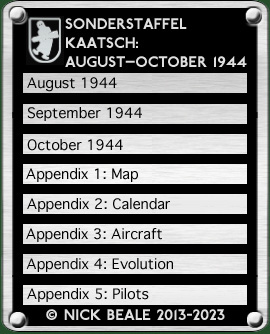|
Evolution While the surviving information has many gaps in it, it does allow a tentative reconstruction of the development of Staffel Kaatsch. What appears to be the only full inventory of its aircraft is a list (see Appendix Five) of 15 Werk Nummern seemingly reflecting the position on the morning of 29 August. This can be deduced from: (a) the absence of Kaatsch Bf 109s lost before that date; (b) the presence another which did not return that afternoon; and (c) the Staffel’s report at 18.45 GMT on 29 August that it had 13 (it had lost one, W.Nr. 441794, that afternoon and so should have had 14 earlier in the day). Aircraft from 4. and 5.(F)/123 Leutnant Weber arrived in Dijon from 5.(F)/123 on the 23rd with Bf 109 G-6, W.Nr. 412169 (Black 19): man and machine are listed as detached in a return of 17.30 hrs (local time). This aircraft was back with its parent unit by afternoon of the 25th but Weber himself remained on detachment. Meanwhile the 5. Staffel had sent two more machines to Dijon on the 24th, together with one from the 4. Staffel, and a “full complement of five” Bf 109s of Sonderstaffel Kaatsch was reported operational there by 06.00 GMT on 25 August. The 5.(F)/123’s position at 17.00 hrs. that day was:
With a reported strength of 12 on 25 August, Staffel Kaatsch appears therefore to have consisted of the five reconnaissance Bf 109s above; W.Nr. 26043, Blue 7, from 4.(F)/123; and seven fighters. Aircraft from Jagdgruppe 200 By the evening of 18th August, Jagdgruppe 200 had had 12 Bf 109s (9 serviceable). Next day it was ordered to withdraw from southern France, but not before losing another Messerschmitt, suggesting that between eight and 11 may have got away. Its aircraft first operated from Dijon on the 23rd but we do not know in what numbers or role. Late in the afternoon of the 25th the Staffel passed an urgent indent for equipment which included ammunition for MK 108. This is significant because the cannon was not carried by reconnaissance variants but it was fitted to the Bf 109 G-6/U4 (e.g. 440 and 441 000 series) which had formed a significant part of JGr. 200’s inventory. Leutnant Moschke’s log mentions aircraft numbered 1, 2, 3, 7, 8 and 11 (such low numbers were common in JGr. 200 but not in 5.(F)/123) but none of these can be tied to a specific Werk Nummer. (The “7” he flew was not W.Nr. 26043, “Blue 7” because that Bf 109 had been lost earlier). Peak strength Some Government Code & Cipher School reports from the summer of 1944 onward include lists of aircraft and engine Werk Nummern occurring in deciphered German traffic and the Bf 109s on the next page were so reported for 29 August 1944. There is no accompanying information to establish a context and the numbers fall in no apparent order but the majority are known to have served with Kaatsch (I have shown these in bold). This suggests to me that the others, if not belonging to the unit, may at least have been on the same airfield (which on this date would have been Dijon). The single aircraft at Saint Dizier was well away from Kaatsch's area of operations and so was probably unrelated to the unit. Discounting that last machine leaves 14 Bf 109s, one of which (as a separate signal confirms) failed to return from a mission that afternoon. Since Kaatsch's strength that evening was 13 (5) aircraft it seems likely that the 14 shown here constituted the inventory of the Staffel on the morning of the 29th. The "remarks" column of the original report is empty, the comments here are mine. continued on next page …
|
|||||||||||||||||||||||||||||||||||||||||||||||||||||||||||||||||||||||||||||||||||||||

